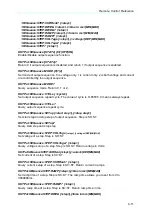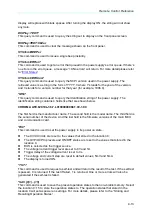
Remote Control Reference
4-1
4.
Remote Control Reference
If you are a new user of the SCPI language, please read this chapter very carefully before
attempting to program the power supply. Incorrectly commanding the power supply could
cause unpredictable operation of the power supply output that may damage connected
devices.
4.1
SCPI Language Summary
4.1.1 SCPI Language Introduction
SCPI is an ASCII-based instrument command language designed for test and measurement
instruments. Its commands are based on a hierarchical structure, also known as a tree
system. In this system, related commands are grouped together under a common node or
root, or formed as subsystems. There is a tree example about a portion of the SOURce
subsystem down here
[SOURce:]
CURRent {<current>|MIN|MAX|UP|DOWN}
CURRent? [MIN|MAX]
CURRent:
TRIGgered {<current>|MIN|MAX}
TRIGgered? {MIN|MAX}
VOLTage {<voltage>|MIN|MAX|UP|DOWN}
VOLTage? [MIN|MAX]
VOLTage:
TRIGgered {<voltage>|MIN|MAX}
TRIGgered? {MIN|MAX}
4.1.2 Symbols Used in SCPI Commands
Before continue introduce the SCPI commands for 62000L series, you need to know the
following notations used for the SCPI command syntax.
Square Brackets ([])
: Indicate optional keywords or parameters, and can be omitted.
The brackets are not sent with the command string.
Braces ({})
: Enclose parameters
within a command string. The braces are not sent with the command string.
Triangle Brackets (<>)
: Indicate that you have to substitute a value or a code for the
enclosed parameter. For example, the SCPI command
CURRent {<current>}
whose
parameter is the current enclosed in triangle brackets means you have to specify a value
for the parameter such as 0.1A. The brackets are not sent with the command string.
A Vertical Bar (|)
: separates one of two or more alternative parameters.
Colon (:)
: Separates a command keyword from a lower-level keyword. For example,
SOURce:CURRent:TRIGgered
.
Blank Space
( ) : A blank space is used to separate a parameter from a command
keyword.
Comma (,)
: A comma (,) is used to separate parameters. For example,
APPLy 36,3
.
Semicolon (;)
: A semicolon (;) is used to separate two command string and let you can
combine two commands in a command string. For example, commanding with the






























